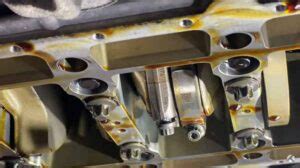Rod Bearing Replacement: Save Your 3.2L VR6 Engine
The 3.2L VR6 engine, a masterpiece of engineering, is renowned for its smooth power delivery and unique sound. However, like any high-performance engine, it's susceptible to wear and tear, and one critical component that demands attention is the rod bearings. A failing rod bearing can lead to catastrophic engine failure, resulting in costly repairs or even a complete engine replacement. This article delves into the importance of rod bearing replacement in your 3.2L VR6, highlighting the signs, causes, and the process involved in saving your beloved engine.
Why are Rod Bearings So Important?
Rod bearings, small but mighty components, are crucial for the health of your engine. They sit between the connecting rods and the crankshaft, providing a critical lubricated interface that allows the crankshaft to rotate smoothly and efficiently. These bearings absorb immense forces during combustion, transferring the power generated to the crankshaft. Without properly functioning rod bearings, your engine faces significant risk.
Signs of Failing Rod Bearings in Your 3.2L VR6
Ignoring the early warning signs of failing rod bearings can have devastating consequences. Be vigilant and look out for these symptoms:
- Knocking Noise: A distinct knocking sound, especially noticeable during acceleration or under load, is a major red flag. This noise indicates the bearings are worn and the connecting rod is impacting the crankshaft.
- Oil Pressure Issues: Low oil pressure, fluctuating oil pressure, or a persistent oil pressure warning light can signal insufficient lubrication of the rod bearings.
- Oil Consumption: Excessive oil consumption can be a subtle indicator of bearing wear, as the oil is escaping past the damaged bearings.
- Performance Issues: Noticeable loss of power, hesitation during acceleration, or rough engine running can all be linked to failing rod bearings. The engine isn't running as smoothly as it should.
- Metal Shavings in the Oil: This is a definitive sign of severe bearing damage. A metal-particle inspection of your oil is a crucial step in diagnosis.
What Causes Rod Bearing Failure in a 3.2L VR6?
Several factors can contribute to rod bearing failure:
- Insufficient Lubrication: Lack of oil or low oil pressure is the most common cause. This can stem from low oil levels, oil pump failure, blocked oil passages, or using the wrong type of oil.
- Wear and Tear: Over time, normal wear and tear can lead to bearing degradation. This is especially true in high-performance applications or with engines that haven't been properly maintained.
- Contaminants in the Oil: Dirt, debris, or other contaminants in the engine oil can accelerate bearing wear and tear. Regular oil changes with high-quality oil are crucial.
- Overheating: Excessive engine temperatures can damage the bearings, causing them to seize or fail.
- Lack of Maintenance: Neglecting regular maintenance, such as oil changes and inspections, significantly increases the risk of rod bearing failure.
How Much Does a Rod Bearing Replacement Cost?
The cost of rod bearing replacement varies depending on several factors, including labor costs, the cost of parts, and the extent of the damage. A preventative replacement, done during a major engine service, might cost less than a repair necessitated by catastrophic failure. It's always advisable to get multiple quotes from reputable mechanics specializing in VR6 engines.
Is it DIY-able?
Replacing rod bearings is a complex and technically demanding procedure. It's not a job for novice mechanics. This requires specialized tools, a deep understanding of engine mechanics, and a clean, well-equipped workspace. Unless you have extensive experience rebuilding engines, it's strongly recommended to entrust this job to a professional mechanic.
Can I Drive My Car with Bad Rod Bearings?
No. Driving a car with bad rod bearings is extremely risky. Continued operation can lead to catastrophic engine damage, including a complete engine seizure. The resulting repair costs will be significantly higher than preventative maintenance. If you suspect a problem with your rod bearings, stop driving the car immediately and get it checked by a mechanic.
How Often Should I Replace My Rod Bearings?
There isn't a set mileage interval for rod bearing replacement. It largely depends on the engine's operating conditions, maintenance history, and the quality of the oil used. However, preventative replacement during a major engine rebuild or at high mileage is a smart move, offering peace of mind and preventing potential problems.
Conclusion: Preventative Maintenance is Key
Investing in preventative maintenance for your 3.2L VR6 engine, including regular oil changes and inspections, is far cheaper than facing the consequences of a catastrophic rod bearing failure. By understanding the signs of bearing wear and taking proactive steps, you can ensure the longevity and performance of your powerful VR6 engine. Remember, regular maintenance is the best insurance policy against costly repairs.

